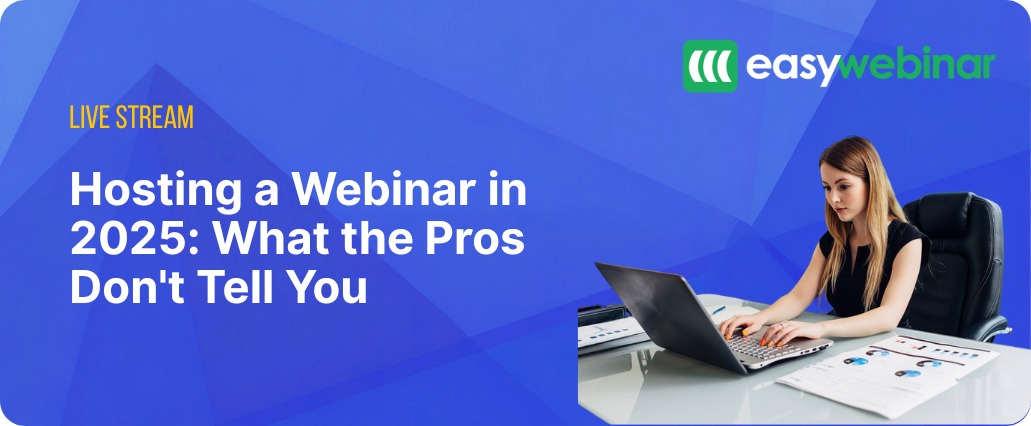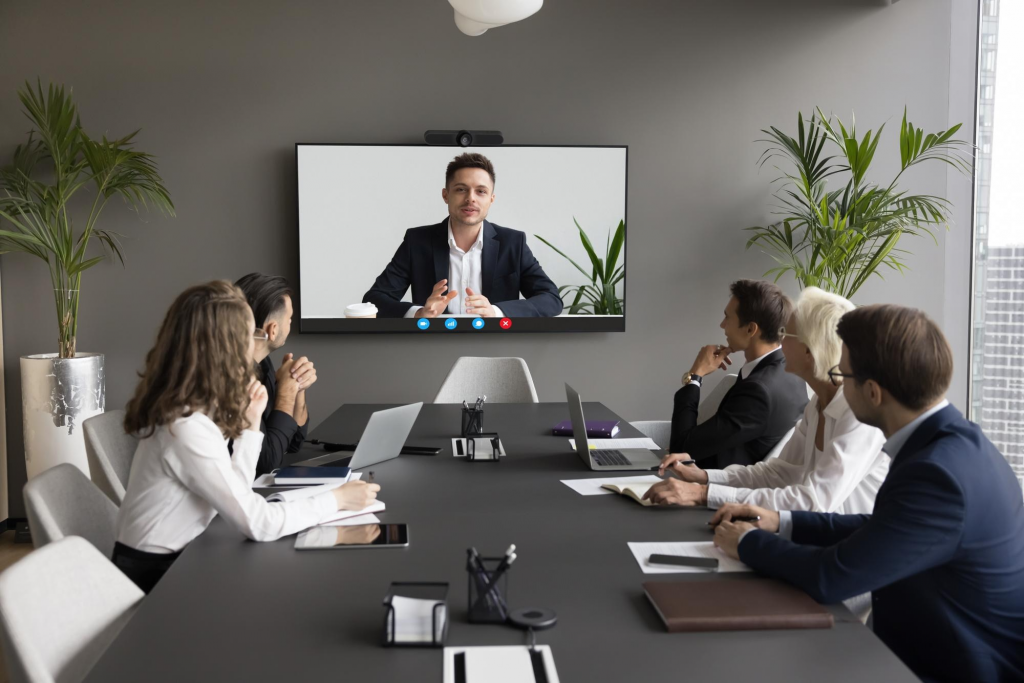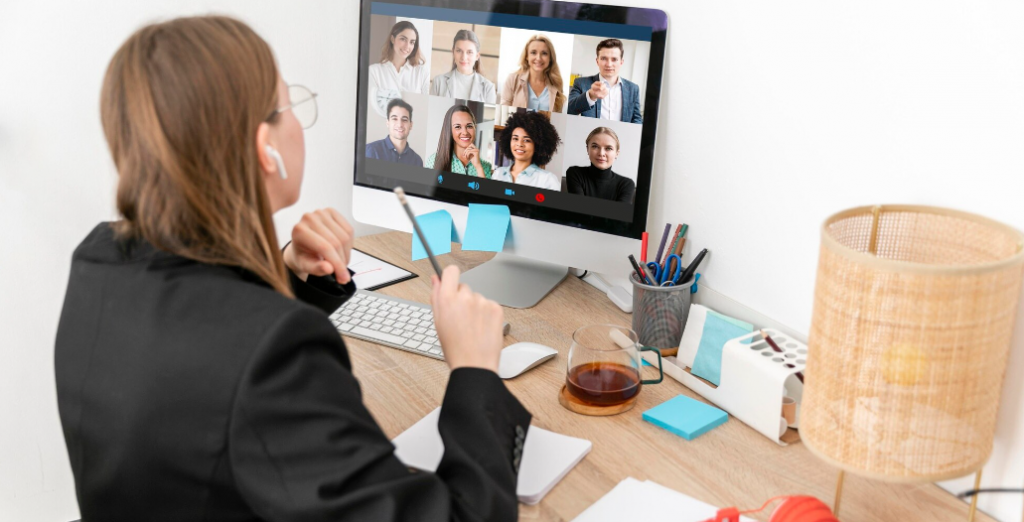Hosting a Webinar in 2025: What the Pros Don’t Tell You

Summary :
Webinars remain one of the most effective tools for lead generation, education, and engagement in 2025. This guide explains how to plan, host, and optimize webinars that drive measurable results. You’ll learn about different webinar types, modern success factors like authenticity and real-time interaction, step-by-step setup using EasyWebinar, and tips to convert attendees into customers. It also covers expert-level advice on rehearsals, backups, and repurposing content for long-term value, turning each live session into an evergreen marketing asset.
Table of Contents
- The Different Types of Live Webinars You Can Host
- What Makes a Webinar Successful in 2025
- How to Host a Webinar: Step-by-Step Breakdown
- Best Practices for Hosting a Webinar That Converts
- What the Pros Don’t Tell You About Webinar Setup
- Repurposing Your Webinar for Long-Term Value
- Conclusion
- FAQs
Marketers have embraced webinars as a vital marketing strategy, with 99% of them calling webinars crucial to their plans. The digital world keeps changing faster as we approach 2025, whether you’re new to online presentations or want to enhance your virtual event expertise.
Success with live webinars needs more than picking a topic and sending out invites. The numbers tell an interesting story – only 58% of people who sign up actually show up. Most consumers feel disconnected from brands, as 57% think that less than half of brand content feels genuine. Enterprise companies face even higher expectations since their audiences won’t tolerate any technical hiccups. This piece will help you create webinars that not only draw crowds but also involve your audience through immediate interaction. You’ll learn to utilize live presentations’ unique advantages to build meaningful connections with your viewers.
The Different Types of Live Webinars You Can Host
Picking the right webinar format is vital to connect with your audience. Your choice should match your specific goals—from educating customers to generating leads. Let’s explore how to select the perfect webinar type that will deliver results in 2025.
Educational and training webinars
Educational webinars help deliver valuable knowledge to your audience. These sessions excel at professional development, skill-based workshops, or certification programs where interaction helps learning.
Your platform needs these features to make educational webinars work:
- Polls and surveys to gauge audience understanding
- Q&A capabilities for clarifying questions
- Resource-sharing options for learning materials
- High-quality recording features for on-demand viewing
Educational webinars let participants join training sessions from anywhere. With EasyWebinar, every session is automatically recorded, so you can instantly repurpose your live training into on-demand educational content. This ensures your lessons remain accessible and valuable long after the live event, extending your reach and impact.
Lead generation and product demos
The right platform makes a big difference in your results when you host lead generation webinars. Research shows that 69% of buyers find product demonstrations most helpful when making purchasing decisions. Your platform should deliver clear video quality, resilient screen-sharing capabilities, and interactive features.
Look for platforms that offer these features for successful lead generation webinars:
- Custom registration fields to capture key information
- Automatic contact routing to custom URLs after registration
- Detailed interaction tracking to identify promising leads
- CRM integration to streamline follow-up
Product demo webinars let you showcase your solutions in real-time. You can address pain points directly and build trust through live interaction. These demonstrations help separate your product from competitors while answering questions that might keep prospects hesitant.
Intellectual influence and Q&A sessions
Thought leadership webinars establish you as an authority while creating valuable connections with your audience. LinkedIn research shows 48% of survey respondents spend at least an hour weekly consuming thought leadership content. About 89% believe it positively affects brand perception. About 49% say thought leadership guides their purchasing decisions.
The best thought leadership webinars combine evidence-based insights with confident delivery. They enable viewers with actionable information while promoting fresh approaches to common challenges. Q&A sessions excel at breaking down barriers between you and your audience.
Q&A sessions work well at strategy presentations, company updates, and all-hands meetings. They give your audience direct access to expertise they might not otherwise have. You also get valuable insights into their priorities and concerns.
Customer onboarding and internal training
Customer onboarding webinars create that vital first impression on new clients. They help reduce support requests by addressing common questions while boosting product adoption through detailed education.
Before the pandemic, about 31% of webinars focused on customer onboarding or training purposes. This percentage has grown with the rise of remote work. A well-designed onboarding webinar eases the manual workload from your customer success team. It provides an engaging visual experience through your product.
Internal training shows equally compelling benefits. Studies show 98% of business leaders recognize video’s value for employee training, with 75% rating it very valuable. Internal webinars cut travel expenses while enabling consistent, quality training that employees access on demand.
Create space for questions and feedback when hosting customer onboarding or internal training webinars. Interactive elements keep participants engaged and help information stick better than passive learning methods.
Understanding these webinar types and choosing the right format for your goals will help you create effective virtual events. These events will deliver measurable results for both your audience and business.

What Makes a Webinar Successful in 2025
The strategies that worked for webinars in the past just don’t work in today’s competitive digital world. Success in 2025 demands a complete transformation in how we approach webinars. Marketing experts have discovered that webinars generate the highest quality leads, with 80% rating them as their most effective content. This makes it more important than ever to understand what drives webinar success.
Authenticity over perfection
Corporate presentations that feel too polished are becoming a thing of the past. Today’s audiences want to connect with real people. Marketers who create webinars that strike a chord with their audience know authenticity is their secret weapon. Quality still matters, but finding the sweet spot between being professional and relatable makes all the difference.
Studies show that viewers trust genuine content and tend to distrust anything that seems over-produced. Your audience can quickly spot canned responses or presenters who aren’t fully engaged, and once that trust breaks, it’s hard to rebuild. This can seriously damage your brand’s authority, especially if you depend on webinars to build your message.
To make your webinars more authentic:
- Share personal insights and experiences that humanize your content
- Be open about challenges instead of pretending everything’s perfect
- Keep your language casual and conversational rather than filled with jargon
- Let unscripted moments showcase your expertise
Note that authenticity needs careful planning and thoughtful execution throughout your webinar process.
Real-time feedback and interaction
Nothing sets successful webinars apart in 2025 quite like their interactive elements. Research shows you lose a percentage of your audience every minute without engagement. But webinars that keep people involved maintain strong attendance throughout the session.
Interactive elements can supercharge your webinar’s impact. To name just one example, Q&A sessions keep audiences engaged 5.5 times longer than traditional presentations. Live polling, chat functions, and Q&A segments have become essential tools for webinar success.
These interactive tools create meaningful moments throughout your presentation. Each poll response, chat message, or question represents a small commitment from participants. Small actions add up to bigger results – data shows that interactive webinars see a 22% higher engagement rate.
Participants who actively engage are 30% more likely to become leads or customers. This explains why top webinar platforms focus on tools that make easier authentic two-way communication.
Why timing and format matter more than ever
A brilliant webinar will flop if scheduled poorly. Data shows that midweek—Thursday, Tuesday, and Wednesday specifically—at 11 am or 2 pm in your audience’s time zone brings the best attendance. But finding the perfect time becomes tricky with global audiences.
Webinar formats have changed dramatically. One-size-fits-all approaches don’t work in 2025’s diverse digital ecosystem. Educational sessions, product demos, and authority presentations each need their own format. Your specific audience and goals should determine the ideal approach.
Most participants enjoy 45-60 minute webinars, challenging the idea that shorter is always better. The sweet spot remains 45-60 minutes for most live webinars, though testing different formats across time zones helps you find what works best for your audience.
Global audiences need automated scheduling with time zone adjustments. Some platforms report attendance rates of 65-90% compared to the typical 40% for traditional live webinars. On-demand options have also become crucial for webinar success.
Focus on being authentic, encourage real-time interaction, and choose your timing and format carefully. This creates webinars that not only attract people but turn them into engaged participants and loyal customers. These elements form the foundation of webinar success in 2025’s sophisticated market.

How to Host a Webinar: Step-by-Step Breakdown
Great webinars don’t just happen. Even seasoned presenters need a well-laid-out approach to create engaging online sessions. Here’s a detailed breakdown of how to host a webinar that keeps your audience hooked from beginning to end.
Planning and scripting your session
Good preparation sets the foundation for webinar success. Your first step should be to define clear, measurable goals that line up with your business objectives. Next, break down your content into logical segments to maintain a smooth flow throughout your presentation.
A skeleton outline helps organize your thoughts and keeps track of your presentation length. This prevents going overtime during the actual event. Your agenda should be a brief summary of each slide’s content placed right at the start of your presentation.
Your script should include these key elements:
- A powerful hook that speaks to your audience’s challenges
- Your expertise established early in the presentation
- Practical, useful guidance with real-life examples
- Questions that get your audience talking
Note that being genuine appeals more than being perfect. Your script should sound conversational and include stories while staying flexible enough to adapt based on live audience feedback.
Setting up your EasyWebinar event
You can set up your EasyWebinar account in just about 10 minutes with the right steps. Once logged in, you can create a new live event or turn a previous successful recording into an automated or evergreen webinar.
For live events, make sure to include these essentials:
- A clear, engaging title and description that highlight your webinar’s value.
- Optimal timing – midweek sessions often attract the best attendance rates.
- Registration settings that capture attendee details effectively.
EasyWebinar offers high-quality HD streaming that supports multiple presenters for smooth and interactive sessions. Depending on your plan, you can host 50 to 200 live attendees, while higher-tier or enterprise plans allow you to scale up with YouTube Live integration, reaching as many as 50,000 viewers.
Before going live, always perform a quick tech check, use a wired internet connection instead of Wi-Fi when possible, close unnecessary applications, and present from a quiet, well-lit space to ensure a seamless experience for your audience.
Running a smooth live session
Begin your backstage prep about 30 minutes before start time. Test your audio, practice speaker transitions, and go over logistics with your team while attendees can’t see or hear you.
Your team needs clear roles:
- Presenters: Share information and answer questions
- Moderator: Controls pace, introduces speakers, handles announcements
- Organizer: Manages technical details, controls recording, and assigns questions
- Question handlers: Screen questions and route them to speakers
Tech issues might pop up despite careful planning. Print your slides, write down phone numbers, have backup presenters ready, and make someone else a co-organizer who can step in if needed.
Keep your audience involved with polls, hand-raising features, and Q&A sessions. Have some questions ready in case audience participation starts slow. These prepared questions often get others to join the discussion.
Recording your webinar is crucial. This lets you turn the content into blog posts, social media clips, and other marketing materials, making your effort count long after the live event ends.
Best Practices for Hosting a Webinar That Converts
Your webinar needs more than information sharing to turn attendees into customers. Strategic planning and thoughtful execution make the difference. Great content should appeal to your audience and guide them toward meaningful action. This separates high-converting webinars from forgettable ones.
Tips to host a webinar that drives action
The best webinars create experiences that connect with audiences at a deeper level. Of course, one basic principle stands out – make your audience feel included and valued during the presentation. Boring, overly technical webinars lead to disengaged participants who rarely convert.
To boost participation and drive action:
- Start early and set expectations. Log into your webinar room before scheduled time, but start a couple minutes after the designated time to let everyone join. This small buffer helps fix technical issues while creating a relaxed atmosphere.
- Create two-way conversations. About 32% of webinar attendees prefer events with passionate, knowledgeable hosts who interact with them throughout. Get chat participation by asking simple questions that prompt responses.
- Provide immediate value. Give practical tips or strategies that attendees can use right away. This could be a checklist, template, or step-by-step guide. People who receive tangible benefits tend to stay engaged and convert later.
- Keep sessions concise. Plan for 45-60 minute webinars to maintain attention without exhaustion. This timeframe lets you deliver value while keeping energy levels high.
Remember that active participants are more likely to take action after your webinar ends.
Using EasyWebinar’s engagement tools
EasyWebinar has several powerful features to boost audience participation. The platform’s chat feature enables smooth, real-time interactions that feel as natural as in-person conversations. Engage in the chat to foster a two-way dialogue during your webinar.
Polls are another effective engagement strategy. You should use 2-3 polls in a 60-minute webinar, spaced every 10-15 minutes. These quick interactive moments keep attendees focused and give valuable insights into their priorities and needs.
Analyzing metrics such as poll responses, offer engagement, and attendee watch time provides valuable insights to refine future webinars for improved results. EasyWebinar’s Interactive Offers feature allows you to showcase your product or service at the perfect moment, adding urgency with countdown timers to encourage quicker decisions from participants.
Creating a strong call-to-action
Your call-to-action (CTA) determines whether participants take the next step in their trip with your brand. Without doubt, a compelling CTA should use strong action words like “buy,” “download,” or “subscribe” that clearly show what viewers should do.
Visual presentation matters a lot—make your CTAs stand out through:
- Contrasting colors that make buttons pop against your presentation
- Strategic placement with at least one CTA “above the fold”
- Clean design with ample white space around the button
- Benefit-focused language that emphasizes value to the viewer
End your webinar with a clear CTA that sends participants to your desired destination—whether that’s a registration form for a future session, a product page, or a demo booking calendar.
Don’t forget about post-webinar engagement. Send personal follow-up emails within 24 hours with a “thank you,” link to the recording, and another chance to act on your offer. This simple step improves conversion rates substantially since attendees are prime candidates to become future customers.

What the Pros Don’t Tell You About Webinar Setup
A lot goes on behind the scenes of a smooth webinar. Most experienced hosts don’t talk about their preparation and backup plans. These hidden elements make the difference between a webinar that flows naturally and one that falls apart.
The importance of rehearsals
You need practice, even as an experienced presenter. Rehearsals do more than help you memorize content—they serve several key purposes. Running through everything helps you spot potential problems with your equipment, internet connection, or presentation flow before your audience sees them.
You should plan at least two rehearsals:
- A content rehearsal to work on timing, transitions, and talking points
- A technical rehearsal to test your entire setup in real conditions
Practice cuts down anxiety significantly. Presenting in new situations can trigger stress even for experienced presenters. When you rehearse in the actual environment you’ll use live, you build familiarity and reduce nervousness. Time each segment during your rehearsal so you don’t rush key content or spend too much time on introductions. EasyWebinar’s Green Room allows you to test your setup in advance and ensure smoother execution during the live session.
Backup plans for tech failures
Tech problems can happen to anyone—yes, it is true even for professional broadcasters. Smart webinar hosts prepare for these situations instead of hoping nothing goes wrong.
Set up a backup internet connection first. This could be a mobile hotspot, another WiFi network, or a hardwired connection. About 83% of webinar technical failures come from internet connectivity problems.
Keep backup devices ready. Load your presentation materials into EasyWebinar in advance or share via screen-share so you can switch quickly if your main device fails. Using EasyWebinar’s built-in presentation upload and sharing tools ensures your content is ready and accessible across webinar sessions.
Create a plan to handle technical issues. Have a simple slide ready that explains the situation while you fix problems. It also helps to practice what you’ll say if things go wrong—staying calm and confident keeps your audience at ease.
How to handle low attendance gracefully
Every webinar host deals with low attendance sometimes. This is a chance to connect better rather than a setback. Smaller audiences often lead to more personal interactions and deeper discussions.
Welcome each attendee by name as they join. This personal approach builds connection right away and shows you care about their presence. You can also shift your style to create an intimate conversation instead of a formal talk.
Give exceptional value to the people who showed up. These participants will support your future events if their experience is amazing. EasyWebinar’s recording features make sure your content reaches people who missed the live session.
Your recorded webinar keeps working for you, no matter how many people attend live. Many webinars get more views from recordings than live attendance, which creates lasting value whatever the original turnout.
Repurposing Your Webinar for Long-Term Value
Your webinar’s value reaches way beyond the reach of its live broadcast date. Content repurposing can boost your audience reach by up to 75% while saving countless hours you’d spend creating new content.
Turning your webinar into evergreen content
A one-time webinar can become an on-demand resource that continues to guide prospects months—maybe even years—after the original broadcast. Evergreen content makes your webinar available to global audiences in all time zones. Viewers can interact with your content at their own pace, which maximizes your investment returns.
Creating clips, blog posts, and social media assets
Your webinar can be broken into smaller, digestible pieces to match a variety of audience priorities:
- Short video clips: You can create 15-60 second segments that express key points for social platforms, perfect to capture attention in today’s 8-second attention span world
- Blog articles: Your transcripts can become SEO-optimized posts that steadily bring organic traffic
- Visual content: Key statistics or insights work well as shareable infographics and graphics
Using EasyWebinar’s replay and analytics features
EasyWebinar’s automated replay feature recreates your live webinar experience, including interactive elements like CTAs, polls, and chat, for on-demand viewers. Replay attendees can still engage with polls, see results, and submit questions that are delivered directly to you via email. You can embed replays on custom pages to tailor the experience for specific audiences. EasyWebinar’s analytics dashboard provides detailed engagement data, including viewer retention, poll interactions, and offer clicks, helping you refine future webinars with performance-driven insights.

Conclusion
Webinars have become vital marketing tools, and their importance will grow through 2025. This piece shows that successful webinars need more than just picking a topic and sending invitations. Your presentations must be authentic because audiences now value genuine connections over perfect production.
Live interaction turns passive viewers into active participants. EasyWebinar’s features like polls, Q&A sessions, and chat help create meaningful moments that boost engagement and lead to conversions. Attendees who take part actively are 30% more likely to become customers.
Good planning makes all the difference in your webinar’s success. Professional presentations stand out from amateur attempts through the right format choice, proper rehearsal, and backup plans. Even experienced hosts face technical issues sometimes – knowing how to handle them gracefully shows your professionalism to the audience.
Your webinar strategy works best as a long-term investment rather than a one-time event. Each presentation opens doors for content that keeps working for your business. EasyWebinar’s replay options let you turn live sessions into valuable on-demand resources that bring in leads long after the original broadcast ends.
The real power of webinars lies in building relationships through valuable content. Conversions happen naturally when you focus on giving exceptional value to your audience. Success comes when participants leave feeling both educated and ready to take the next step with your brand.
You can start using these proven strategies now. Sign up for EasyWebinar to turn your virtual presentations from simple broadcasts into engaging experiences that bring measurable business results. The simplified setup, execution, and content repurposing will save you time too.
FAQs
Q1. Are webinars still an effective marketing tool in 2025?
Yes, webinars remain highly effective in 2025. Recent studies show that 95% of marketers consider webinars important to their strategy, and 73% of B2B marketers report webinars as their top source of high-quality leads. The continued popularity of webinars across industries demonstrates their enduring value as a marketing tool.
Q2. What are some key tips for presenting an effective webinar?
To present an effective webinar, focus on authenticity over perfection, encourage real-time interaction with your audience, and carefully plan your content and timing. Use engagement tools like polls and Q&A sessions, practice your presentation, and be prepared with backup plans for technical issues. Additionally, create a strong call-to-action and follow up with attendees after the event.
Q3. How can I choose the right format and platform for my webinar?
Select a webinar format that aligns with your specific goals, such as educational sessions, product demos, or thought leadership presentations. Consider your audience’s preferences and the nature of your content. When choosing a platform, look for features like HD streaming, interactive tools, and analytics. EasyWebinar, for example, offers various options to accommodate different webinar types and audience sizes.
Q4. What’s the ideal length for a webinar, and when is the best time to host one?
The ideal length for most webinars is 45-60 minutes. This duration allows you to deliver valuable content while maintaining audience engagement. As for timing, midweek days (particularly Tuesday, Wednesday, and Thursday) at 11 am or 2 pm in your audience’s local time zone tend to yield optimal attendance. However, for global audiences, consider offering on-demand options to accommodate various time zones.
Q5. How can I maximize the value of my webinar after the live event?
To extend the value of your webinar, repurpose it into various content formats. Turn the recording into an on-demand resource, create short video clips for social media, write blog posts based on the content, and develop infographics from key insights. Use your webinar platform’s replay and analytics features to track engagement and continually refine your approach. This strategy can increase your audience reach by up to 75% and provide long-term value from a single event.